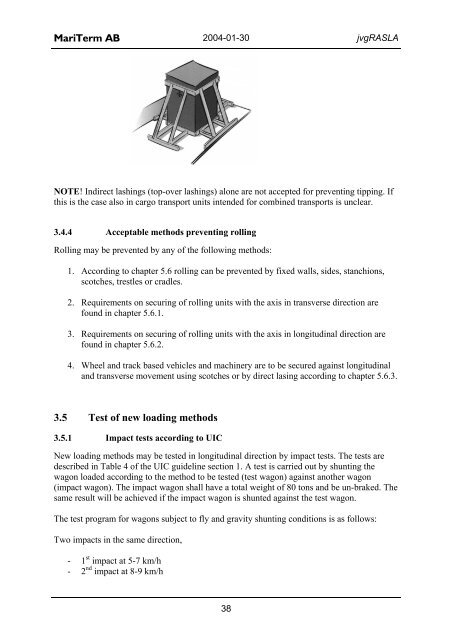Equipment for Rational Securing of Cargo on Railway ... - Vinnova
Equipment for Rational Securing of Cargo on Railway ... - Vinnova
Equipment for Rational Securing of Cargo on Railway ... - Vinnova
Create successful ePaper yourself
Turn your PDF publications into a flip-book with our unique Google optimized e-Paper software.
MariTerm AB 2004-01-30 jvgRASLA<br />
NOTE! Indirect lashings (top-over lashings) al<strong>on</strong>e are not accepted <str<strong>on</strong>g>for</str<strong>on</strong>g> preventing tipping. If<br />
this is the case also in cargo transport units intended <str<strong>on</strong>g>for</str<strong>on</strong>g> combined transports is unclear.<br />
3.4.4 Acceptable methods preventing rolling<br />
Rolling may be prevented by any <str<strong>on</strong>g>of</str<strong>on</strong>g> the following methods:<br />
1. According to chapter 5.6 rolling can be prevented by fixed walls, sides, stanchi<strong>on</strong>s,<br />
scotches, trestles or cradles.<br />
2. Requirements <strong>on</strong> securing <str<strong>on</strong>g>of</str<strong>on</strong>g> rolling units with the axis in transverse directi<strong>on</strong> are<br />
found in chapter 5.6.1.<br />
3. Requirements <strong>on</strong> securing <str<strong>on</strong>g>of</str<strong>on</strong>g> rolling units with the axis in l<strong>on</strong>gitudinal directi<strong>on</strong> are<br />
found in chapter 5.6.2.<br />
4. Wheel and track based vehicles and machinery are to be secured against l<strong>on</strong>gitudinal<br />
and transverse movement using scotches or by direct lasing according to chapter 5.6.3.<br />
3.5 Test <str<strong>on</strong>g>of</str<strong>on</strong>g> new loading methods<br />
3.5.1 Impact tests according to UIC<br />
New loading methods may be tested in l<strong>on</strong>gitudinal directi<strong>on</strong> by impact tests. The tests are<br />
described in Table 4 <str<strong>on</strong>g>of</str<strong>on</strong>g> the UIC guideline secti<strong>on</strong> 1. A test is carried out by shunting the<br />
wag<strong>on</strong> loaded according to the method to be tested (test wag<strong>on</strong>) against another wag<strong>on</strong><br />
(impact wag<strong>on</strong>). The impact wag<strong>on</strong> shall have a total weight <str<strong>on</strong>g>of</str<strong>on</strong>g> 80 t<strong>on</strong>s and be un-braked. The<br />
same result will be achieved if the impact wag<strong>on</strong> is shunted against the test wag<strong>on</strong>.<br />
The test program <str<strong>on</strong>g>for</str<strong>on</strong>g> wag<strong>on</strong>s subject to fly and gravity shunting c<strong>on</strong>diti<strong>on</strong>s is as follows:<br />
Two impacts in the same directi<strong>on</strong>,<br />
- 1 st impact at 5-7 km/h<br />
- 2 nd impact at 8-9 km/h<br />
38
















